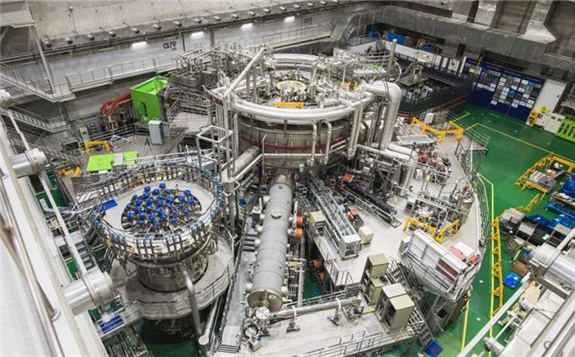Korea’s national artificial sun nuclear fusion reactor has set a new record by running at 100 million degrees Celsius for a full 20 seconds.

Fusion may be a decade away, but even a few seconds make a big difference at this stage. Let’s take a closer look—from a safe distance, of course.
Korea Superconducting Tokamak Advanced Research (KSTAR) achieved first fusion in 2008 and is considered a kind of farm league for France's huge international ITER project, the fusion reactor has millions of individual parts that will eventually form the world's largest tokamak.
Korea built some of the sections of that tokamak’s vacuum container, will make the thermal shields that surround the reactor’s huge magnets, and is now working on making two of the gigantic tools that will assemble the sections. But Korea's contribution extends beyond manufacturing, as the country is also offering technological insights based on 12 years and counting of intellectual work and insights from KSTAR.
The Korean Institute of Fusion Energy (KFE) operates KSTAR with the goal of achieving fusion ignition for 300 seconds at a time. KFE has performed well over 20,000 plasma jolts since 2008. And in that same timeframe, the institute has continued to iterate new features and design ideas.
“In its 2020 experiment, the KSTAR improved the performance of the Internal Transport Barrier (ITB) mode, one of the next generation plasma operation modes developed last year and succeeded in maintaining the plasma state for a long period of time, overcoming the existing limits of the ultra-high-temperature plasma operation,” KSTAR authorities said in a statement.
ITB mode at KSTAR dates back to 2016, when researchers found that controlling the technological phenomenon was effective in lengthening their hot plasma time. “Internal transport barriers can be defined as regions of the core plasma where turbulent transport is reduced or quenched,” a 2006 paper explains. “The triggering and sustainment of ITBs are complex issues and are known to depend on a large number of factors.”
ITB must be well understood in order to minimize the stanching as well as amplifying effects of these barriers on the resulting sustained fusion.
Computers have allowed researchers to study ITB and find the sweet spot where these zones induce turbulence transport—a desirable plasma state where chaotic flow areas help regulate the overall state of the plasma inside a reactor like a tokamak. KSTAR is now a major beneficiary of these studies, absolutely demolishing the existing sustained plasma record to stay at 100 million degrees Celsius for a full 20 seconds.
KSTAR officials say this is a major milestone for their reactor, which they believe is on track to reach 300 seconds at 100 million degrees Celsius by 2025. That also leaves plenty of time for their insights to roll over into ITER, whose construction, piece by piece, will take years before the planned first ignition in 2030.
This article is reproduced at www.popularmechanics.co